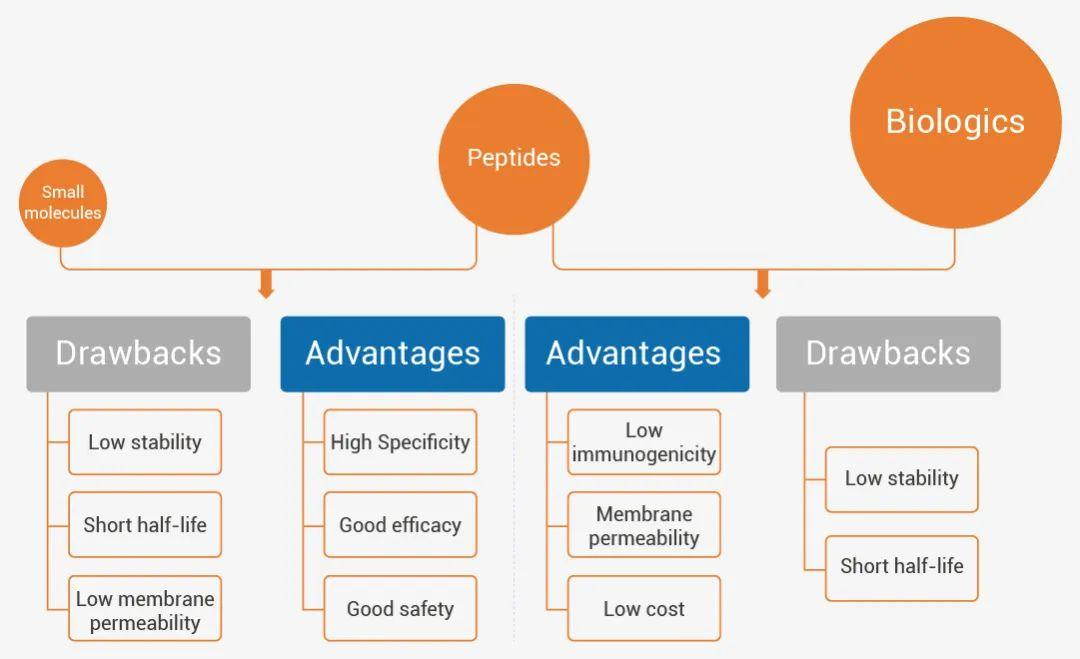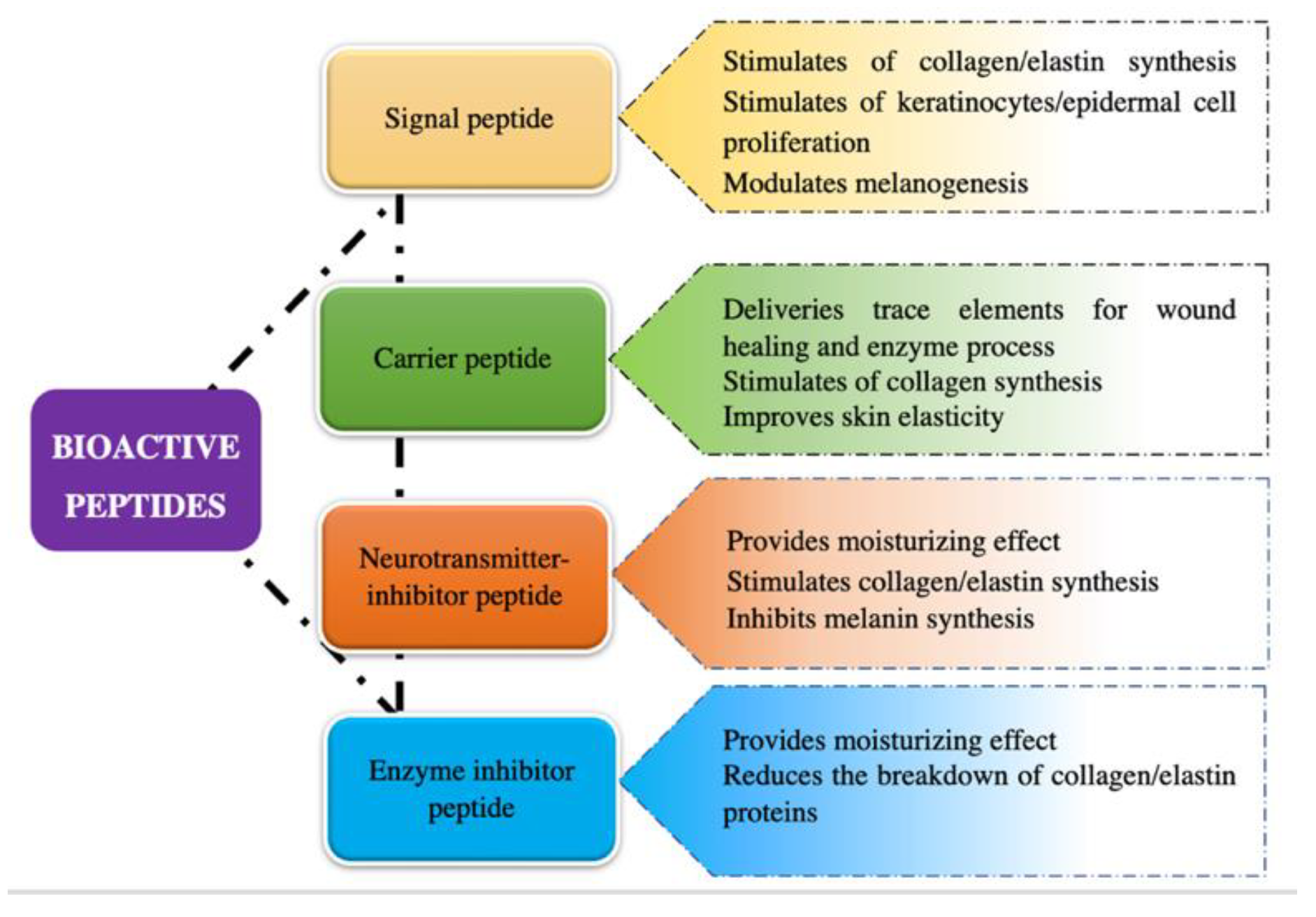Peptide Drugs:Unique Position and In-depth Popular Science
Peptides hold a unique and significant position in the field of drug research and development.Since the advent of therapeutic insulin in 1922,peptides have played an irreplaceable role in medical practice.Today,more than a hundred peptide-based drugs have been approved for marketing globally,and they are widely used in the treatment of a variety of diseases,including diabetes,tumors,chronic pain,and multiple sclerosis.

I.Advantages of Peptides
Peptides are composed of amino acids,with a molecular weight generally below 10 KDa,placing them between small-molecule chemicals and biologics.Their main advantages lie in their high selectivity and low effective concentration.Classic therapeutic peptides,such as hormones,growth factors,and ion-channel ligands,trigger intracellular effects by binding to receptors.Compared with biologics(such as antibodies and therapeutic proteins),peptides have lower immunogenicity.Moreover,since they can be chemically synthesized,their production costs are also relatively low.Compared with small-molecule drugs,peptides have a larger molecular weight,which enables them to more effectively inhibit protein-protein interactions(PPI),thereby offering higher selectivity and specificity,lower effective concentrations,and fewer side effects.

II.Types of Peptide Drugs
(I)Hormonal Peptides and Their Derivative Drugs
There are four main types of pharmaceutical peptides in clinical use,among which hormonal peptides and their derivative drugs are an important category.Early peptide drug research mainly focused on the field of human-sourced hormone peptides with low effective concentrations,such as insulin,oxytocin,antidiuretic hormone,somatostatin,and gonadotropin-releasing hormone,which are short-peptide drugs that pioneered and enriched the field of peptide drugs,and many of them are still in use today.With in-depth research,people have improved the properties of peptide hormones through chemical modification methods such as C-terminal amidation,D-amino acids,cyclization,and conjugation with long-chain fatty hydrocarbons.For example,Octreotide and Pasireotide are modified based on the β-turn pharmacophore of somatostatin to prolong their half-lives.In addition,it is also possible to develop related agonists or antagonists based on peptide-like hormones,such as Goserelin and Cetrorelix.
(II)Natural Peptide Products
In addition to human-sourced peptides,there are also natural peptide products derived from animals,plants,and microorganisms.Typical natural active peptides include secondary metabolites of microorganisms,as well as active peptides isolated from the venom of amphibians and insects.For example,ICK peptides are a classic class of venom peptides.Their disulfide-bond structure endows them with extraordinary stability and resistance to proteases,making them suitable as drug-like lead compounds.Ziconotide is an ICK peptide derived from the venom of the toxic cone-shaped snail,which has a good analgesic effect.
(III)Peptide Vaccines
Peptide vaccines are subunit vaccines made from peptides that stimulate an immune response in the body by mimicking the epitope sequences of antigens.For example,Multimeric001 is an anti-infectious peptide vaccine that contains epitopes of influenza virus B,T-helper cells,and cytotoxic T cells,and can prevent a variety of type A and type B influenza viruses.It has now entered phase III clinical trials.Compared with traditional inactivated and attenuated vaccines,peptide vaccines can not only prevent infectious or non-infectious diseases but also be used to treat diseases such as Alzheimer's disease and malignant tumors.Disomotide,for example,is a melanoma antigen based on Gp100:209-217,which can promote the production of cytotoxic T lymphocytes(CTL)to recognize natural G209 and melanoma cells.It is currently in phase III clinical trials.
(IV)PDC Peptide Drugs
PDC(peptide-drug conjugates)peptide drug delivery systems are also a direction of clinical research.Peptides,due to their good bioactivity,non-toxicity,and compatibility,can serve as drug carriers.For example,177Lu-dotatate(lutathera®)has been approved by the FDA for the treatment of neuroendocrine tumors.PDCs are formed by covalent bonding of peptides and drugs through linkers,retaining the function and bioactivity of peptides while using the cleavable properties of linkers to release drugs responsively,thereby improving the stability and targeting of drugs in the body and reducing toxicity and side effects.PDCs can enter cells directly through peptides or by endocytosis to release drugs.
Thank you for your attention and support! We are a company specializing in the research, development, and production of GLP-1 API (Active Pharmaceutical Ingredient), committed to providing high-quality raw pharmaceutical products to our clients. If you have any related needs or would like to learn more, please feel free to contact us at any time!
Contact Information:
Email: laura@horwats.com
Phone: +86 19052757106
We look forward to collaborating with you to drive progress in the pharmaceutical and healthcare fields, delivering better medical solutions to patients worldwide!




